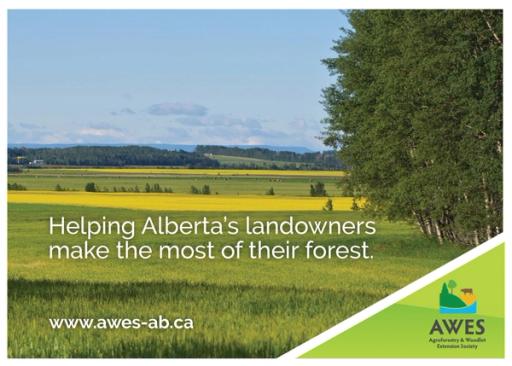June 15, 2020
Your Trees do have Value

by the Agroforestry & Woodlet Extension Society
Most people that live in Alberta have trees as part of their landscape. That can be in the yard around their home as ornamentals and fruit trees, or it can be in rural Alberta as large tracts of natural native trees that existed prior to any land clearing or shelterbelts and windbreaks that have been planted over the years. Those trees have a large variety of value to the owners and the communities in the province. So how do you find out those values and what can you do manage or improve those values?
In 2019 the Agroforestry & Woodlot Extension Society initiated a project, with support from the Alberta Real Estate Foundation, to assist primarily rural landowners of acreages and farms in learning about the value of their trees and also how manage aspects of the trees to improve the growth and quality of the trees and the overall value of their property. However, the project efforts can also benefit landowners in cities, towns, and small hamlets as all these areas have plenty to trees and can use some assistance.
The project involved meeting with landowners talking about their treed area or about an area they would like in trees and providing them advise on best way to achieve their goals. In many cases, the conversation turned to how to successfully plant more trees or how to improve the health and growth of their existing trees. Over the past year the program resulted in benefits to over 30 landowners, leading to six new planting projects that involved planting over 20,000 trees on private lands in central and northwest Alberta. It also has the potential of creating another 6-8 projects that will be planted in the spring of 2021, with a growing number as the project proceeds.

So, what are some of the values that might come from your trees? There are obvious values like producing wood if the tree is cut down, to be used in the manufacture of many things, including most of the homes in Alberta, but there are a lot of other values that they can provide as they stand and live in our backyards. As examples: trees will affect the microclimate (climate of a localised area) around them, primarily by altering wind, potentially reducing heating and cooling costs by 17.5% – 25%, and protecting livestock; they act as a physical buffer for odours and particulates, improving air quality; the reduction of wind speed prevents the movement of valuable topsoil off of fields and helps prevent the drying situation that leads to loose soils in the first place. One of the most beneficial synergies of trees is in how they interact with water and water bodies on a property. Their ability to control snow can be quite extensive, and they can act as water filters for runoff. Wooded areas also offer a variety of habitats for wildlife, which in turn offer their own benefits.
This partnership has allowed us to demonstrate that there are many and varied values the forested areas and trees can have, from their economic values to their inherent value as natural areas. Due to the complexity of these forested areas and trees, it is important to look at each case individually, and assess a forest or shelterbelt’s value on a case-by-case basis. All of this is explained in detail in the educational document produced as part of the project on the many and wonderful values that trees provide to people.


